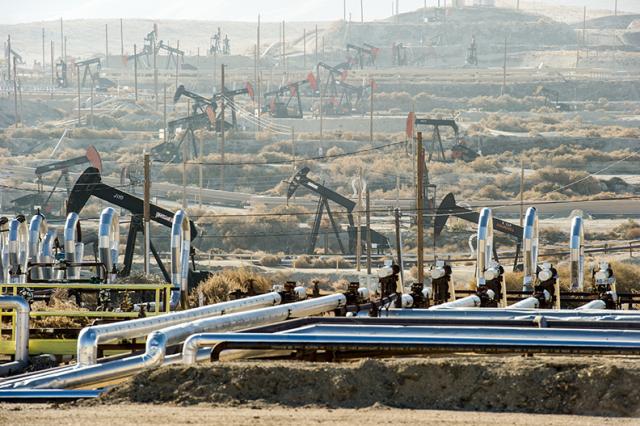
A proposal by the Trump administration to open up more than a million acres of federal public land in California to hydraulic fracturing could be a good opportunity for producers while other experts say it is not economical.
The U.S. Bureau of Land Management (BLM) made the first move to open up 1.6 million acres in California for new oil and natural gas leases. The government agency said the lands managed by them in San Luis Obispo, Fresno and six other San Joaquin Valley and Central Coast counties are being considered.
The plan will be met with severe resistance from environmentalists in the state that has already planned to protest any new hydraulic fracturing by enacting a ballot measure for the fall in San Luis Obispo, which is located in the central coast region.
California oil companies were the third largest producers of petroleum in 2016, but the state is often overlooked by investors and competitors. While Texas and North Dakota lead the U.S. in production, California finds itself in a unique position because it imports 70% of its crude oil. The state also saw a decline in production in 2017 to 3.53 million barrels in February, according to data from the Energy Information Administration (EIA), the independent statistical arm of the Department of Energy based in Washington, D.C.
California’s federal production averages 8% to 10% of the state’s total oil and natural gas production, according to the BLM, which currently manages nearly 600 producing oil and gas leases covering more than 200,000 acres and 7,900 usable. Over 95% of federal drilling occurs in fields in the Kern County area of the San Joaquin Valley.
While the levels of petroleum produced from hydraulic fracturing in California pales in comparison to the Permian Basin, producers have utilized it in deeper wells in Colusa, Glenn, Kern, Los Angeles, Monterey, Sacramento, Santa Barbara, Sutter, Kings and Ventura counties either currently or in the past, said Patrick Morris, CEO of NY-based HAGIN Investment Management.
Hydraulic fracturing in California can be economical, but the challenge there and in many other states like Colorado is finding a balance between environmentalists and the energy industry. The biggest issue facing California is the “tremendous” potential resource in the Monterey Shale, which would require large-scale hydraulic fracturing, Morris said.
The additional issue in California is water usage. Since the agricultural industry is the largest commercial consumer of water, widespread hydraulic fracturing in Monterey would put additional pressure on resources.
“In a draught/deluge state like California, the water issue is a major one,” Morris said. “Advances in frack solution formulations like gels and salt water might mitigate this issue. Obviously, I favor policies that balance the needs of the community with the needs of industry.”
The fight in California and many other states is the right of the voter to set certain industry standards.
“This is a big state’s rights issue and one that is unlikely to be resolved quickly,” he said.
Most of the current production in California is completed by conventional drilling. Since the state has tremendous reserves, there are more opportunities for producers, said Bernard Weinstein, associate director of the Maguire Energy Institute at Southern Methodist University's Cox School of Business in Dallas.
“There are untapped resources in the shale plays both onshore and offshore,” he said.
If regulations on hydraulic fracturing are reasonable, more producers will be eager to conduct additional operations in California, Weinstein said.
“Some producers see the potential in California and will reach an agreement where restrictions on fracking aren’t so severe and unprofitable,” he said. “It will be interesting to see what happens.”
Previous federal auctions in the Gulf of Mexico have not been successful while in other parts of the U.S., seismic testing is being conducted on the Atlantic coast.
“If there isn’t more drilling in California, states such as Texas, North Dakota or Louisiana will pick up the slack—there are plenty of basins,” Weinstein said.
Additional hydraulic fracturing also means the state will have the opportunity to create more jobs and income and generate extra tax revenue.
“It remains to be seen if California will come up with fracking regulations to encourage it,” he said.
If operators are permitted to drill on federal land, the producers would only displace about 130,000 of barrels of oil per day of intermediate to light crude oil, said Ryan Smith, director of research at East Daley Capital in Centennial, Colo. California companies are producing 475,000 of barrels of oil a day currently.
One issue is that the refineries in California were constructed to mostly handle feedstock of heavier crude oil. Some refiners conducted a retrofit to process intermediate crude oil when production in the Bakken rose. If production rose by more than 130,000 barrels of oil per day, producers would be forced to ship it elsewhere, making it an expensive option.
“There is a limit to how much California refiners can handle,” Smith said, adding that an increase in oil production could be expensive for some producers.
“There is no evidence which proves that drilling in any of the oil reserves is economical,” he said.
“It looks like a long shot. There is hardly any recent horizontal drilling in California and most of the current production comes from vertical drilling.”
Opening up federal land to hydraulic fracturing could be a major move, but the chances that it is as inexpensive as drilling in the Bakken or Permian are pretty low, Smith said. Operators should focus on shallow areas such as Bakersfield where it is cheaper to drill.
Recommended Reading
As US Ethane Production Soars to Record High, Low Prices Expected
2024-10-29 - Tied to natural gas production, which has suffered from weak demand, ethane is also headed for bearish prices, according to an analyst.
What's Affecting Oil Prices This Week? (Sept. 23, 2024)
2024-09-23 - For the upcoming week, oil prices could get a boost from another storm forming in the Gulf of Mexico that could be a hurricane by the evening of Sept. 25 and possibly affect much of the eastern Gulf Coast.
What's Affecting Oil Prices This Week? (Sept. 16, 2024)
2024-09-16 - With expectations for more favorable supply/demand fundamentals and improvement in the sentiment of oil traders, Stratas Advisors forecast higher oil prices with the price of Brent crude moving back above $80.
NatGas Storage Drops Ahead of Predictions
2024-11-21 - U.S. Energy Information Administration's weekly report shows the first withdrawal of the fall, a week before the consensus forecast.
US NatGas Prices Slide 2% as Mild Weather Keeps Storage Injections High
2024-11-07 - U.S. natural gas futures have fallen on forecasts for weather to remain mild through late November.
Comments
Add new comment
This conversation is moderated according to Hart Energy community rules. Please read the rules before joining the discussion. If you’re experiencing any technical problems, please contact our customer care team.





